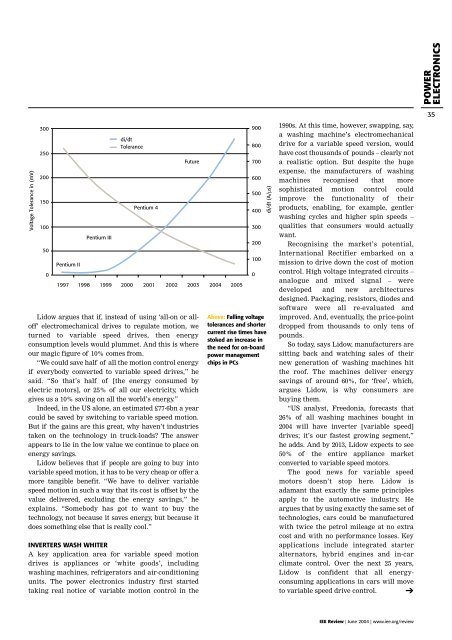TAKES CONTROL - International Rectifier
TAKES CONTROL - International Rectifier
TAKES CONTROL - International Rectifier
You also want an ePaper? Increase the reach of your titles
YUMPU automatically turns print PDFs into web optimized ePapers that Google loves.
POWER<br />
ELECTRONICS<br />
Voltage Tolerance in (mV)<br />
300<br />
250<br />
200<br />
150<br />
100<br />
50<br />
0<br />
Pentium II<br />
Pentium III<br />
di/dt<br />
Tolerance<br />
Pentium 4<br />
Future<br />
1997 1998 1999 2000 2001 2002 2003 2004 2005<br />
Lidow argues that if, instead of using ‘all-on or alloff’<br />
electromechanical drives to regulate motion, we<br />
turned to variable speed drives, then energy<br />
consumption levels would plummet. And this is where<br />
our magic figure of 10% comes from.<br />
“We could save half of all the motion control energy<br />
if everybody converted to variable speed drives,” he<br />
said. “So that’s half of [the energy consumed by<br />
electric motors], or 25% of all our electricity, which<br />
gives us a 10% saving on all the world’s energy.”<br />
Indeed, in the US alone, an estimated £77.6bn a year<br />
could be saved by switching to variable speed motion.<br />
But if the gains are this great, why haven’t industries<br />
taken on the technology in truck-loads? The answer<br />
appears to lie in the low value we continue to place on<br />
energy savings.<br />
Lidow believes that if people are going to buy into<br />
variable speed motion, it has to be very cheap or offer a<br />
more tangible benefit. “We have to deliver variable<br />
speed motion in such a way that its cost is offset by the<br />
value delivered, excluding the energy savings,” he<br />
explains. “Somebody has got to want to buy the<br />
technology, not because it saves energy, but because it<br />
does something else that is really cool.”<br />
INVERTERS WASH WHITER<br />
A key application area for variable speed motion<br />
drives is appliances or ‘white goods’, including<br />
washing machines, refrigerators and air-conditioning<br />
units. The power electronics industry first started<br />
taking real notice of variable motion control in the<br />
900<br />
800<br />
700<br />
600<br />
500<br />
400<br />
300<br />
200<br />
100<br />
0<br />
di/dt (A/µs)<br />
Above: Falling voltage<br />
tolerances and shorter<br />
current rise times have<br />
stoked an increase in<br />
the need for on-board<br />
power management<br />
chips in PCs<br />
1990s. At this time, however, swapping, say,<br />
a washing machine’s electromechanical<br />
drive for a variable speed version, would<br />
have cost thousands of pounds – clearly not<br />
a realistic option. But despite the huge<br />
expense, the manufacturers of washing<br />
machines recognised that more<br />
sophisticated motion control could<br />
improve the functionality of their<br />
products, enabling, for example, gentler<br />
washing cycles and higher spin speeds –<br />
qualities that consumers would actually<br />
want.<br />
Recognising the market’s potential,<br />
<strong>International</strong> <strong>Rectifier</strong> embarked on a<br />
mission to drive down the cost of motion<br />
control. High voltage integrated circuits –<br />
analogue and mixed signal – were<br />
developed and new architectures<br />
designed. Packaging, resistors, diodes and<br />
software were all re-evaluated and<br />
improved. And, eventually, the price-point<br />
dropped from thousands to only tens of<br />
pounds.<br />
So today, says Lidow, manufacturers are<br />
sitting back and watching sales of their<br />
new generation of washing machines hit<br />
the roof. The machines deliver energy<br />
savings of around 60%, for ‘free’, which,<br />
argues Lidow, is why consumers are<br />
buying them.<br />
“US analyst, Freedonia, forecasts that<br />
26% of all washing machines bought in<br />
2004 will have inverter [variable speed]<br />
drives; it’s our fastest growing segment,”<br />
he adds. And by 2013, Lidow expects to see<br />
50% of the entire appliance market<br />
converted to variable speed motors.<br />
The good news for variable speed<br />
motors doesn’t stop here. Lidow is<br />
adamant that exactly the same principles<br />
apply to the automotive industry. He<br />
argues that by using exactly the same set of<br />
technologies, cars could be manufactured<br />
with twice the petrol mileage at no extra<br />
cost and with no performance losses. Key<br />
applications include integrated starter<br />
alternators, hybrid engines and in-car<br />
climate control. Over the next 25 years,<br />
Lidow is confident that all energyconsuming<br />
applications in cars will move<br />
to variable speed drive control. ➔<br />
35<br />
IEE Review | June 2004 | www.iee.org/review

















